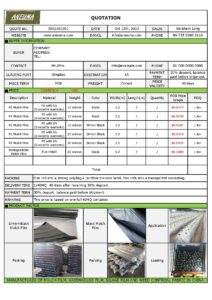Table of Contents
Introduction
Mulch film is a valuable tool in modern agriculture, providing numerous benefits for growers. It acts as a protective layer, improving weed control, moisture conservation, and soil temperature regulation. As growers explore the potential of mulch film, it’s important to understand the different types available and their specific applications.

Black Mulch Film
Black mulch film is one of the most commonly used types. It is made of opaque black plastic and helps suppress weed growth by blocking sunlight from reaching the soil surface. Additionally, black mulch film absorbs heat, raising the soil temperature and promoting early crop growth. It is widely used for vegetables, fruits, and other row crops where weed control and soil warming are critical.

Clear/Transparent Mulch Film
Clear mulch film, also known as transparent mulch film, is made of translucent plastic that allows sunlight to penetrate the soil. This type of mulch film is particularly useful in early-season crop production, as it promotes faster germination and establishment by harnessing solar radiation. Clear mulch film is also effective in weed control by increasing soil temperature, which inhibits weed seed germination. It is commonly used for crops like melons, cucumbers, and strawberries.

Colored Mulch Film
Colored mulch films, available in various hues such as red, blue, and silver, have gained popularity due to their specific properties and applications. Red mulch film, for example, helps stimulate early fruiting and enhances tomato and strawberry yields. Blue mulch film improves plant growth and yield in crops like peppers and cabbage. Silver mulch film reflects sunlight and repels certain insect pests. The color selection depends on the crop type and desired outcomes, offering growers flexibility and targeted benefits.
Biodegradable Mulch Film
In response to environmental concerns, biodegradable mulch film has emerged as a sustainable alternative. Made from biodegradable materials like starch or cellulose, this type of mulch film breaks down naturally over time, reducing the need for removal and disposal. Biodegradable mulch film is particularly suitable for organic farming practices, as it aligns with the principles of reducing plastic waste and minimizing environmental impact. However, it’s important to consider factors such as degradation rate, soil conditions, and crop cycle length when choosing biodegradable mulch film.
Metallic Reflective Mulch Film
Metallic reflective mulch film, often silver or aluminum-coated, offers unique benefits in crop production. It reflects sunlight back onto the plants, increasing light intensity and promoting photosynthesis. This can result in improved crop growth and yield. Additionally, the reflective properties of metallic mulch film confuse certain insect pests, reducing pest pressure. It is commonly used for crops like tomatoes, peppers, and melons.
Selecting the Right Mulch Film for Your Needs
When choosing the appropriate mulch film, it’s essential to consider factors such as crop type, climate, desired outcomes, and specific requirements. Conducting trials and experimentation can help determine the most effective mulch film for your specific circumstances. It’s also important to adapt and adjust based on observations and feedback from the crops to optimize results.
Conclusion
As growers harness the benefits of mulch film in agriculture, understanding the different types available is crucial. Whether it’s black mulch film for weed control, clear mulch film for early-season growth, colored mulch film for targeted benefits, biodegradable mulch film for sustainability, or metallic reflective mulch film for increased light intensity, each type has its own applications and advantages. By selecting the right mulch film based on crop type, climate, and desired outcomes, growers can optimize weed

